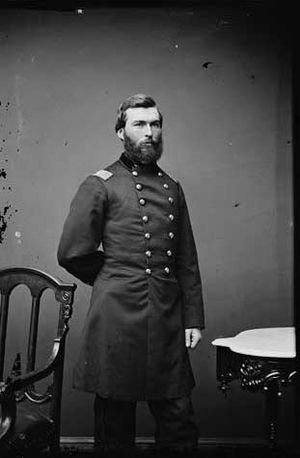Thomas H. Ruger facts for kids
Quick facts for kids
Thomas Howard Ruger
|
|
|---|---|
 |
|
| Born | April 2, 1833 Lima, New York |
| Died | June 3, 1907 (aged 74) Stamford, Connecticut |
| Place of burial |
West Point Cemetery
|
| Allegiance | United States of America Union |
| Service/ |
United States Army Union Army |
| Years of service | 1854–1855, 1861–1897 |
| Rank | |
| Commands held | Department of the Missouri Department of Dakota Department of California Department of the East |
| Battles/wars | American Civil War |
| Signature | |
Thomas Howard Ruger (April 2, 1833 – June 3, 1907) was an American soldier and lawyer. He served as a general for the Union Army during the American Civil War. After the war, he became the leader, or superintendent, of the famous West Point military school in New York.
Contents
Early Life and Education
Thomas Ruger was born in Lima, New York, in 1833. In 1846, his family moved to Janesville, Wisconsin. He attended the United States Military Academy, also known as West Point. He graduated in 1854, ranking third in his class of 46 students. After graduating, he became a second lieutenant in the U.S. Army Corps of Engineers. However, he left the army in 1855 to become a lawyer in Wisconsin.
Civil War Service
When the Civil War began, Ruger rejoined the army. In June 1861, he was appointed a lieutenant colonel in the 3rd Wisconsin Volunteer Infantry Regiment. He was promoted to colonel in August of the same year.
Early Campaigns
Colonel Ruger led his regiment in battles in Maryland and the Shenandoah Valley. He fought in the Battle of Antietam, where he was wounded. During this battle, he was temporarily in charge of a larger group of soldiers called a brigade.
In November 1862, Ruger was promoted to brigadier general. He led his brigade in the Battle of Chancellorsville. At the Battle of Gettysburg, he temporarily commanded a division of soldiers. Later in 1863, General Ruger went to New York City. There, he helped to stop the New York Draft Riots, which were large protests against the military draft.
Later Battles
General Ruger then led a brigade in Major General William T. Sherman's Atlanta Campaign. This was a major series of battles in Georgia. In November 1864, he joined the campaign against Confederate General John B. Hood's army in Tennessee. Ruger was recognized for his service at the Battle of Franklin. He was given a special rank of brevet major general of volunteers.
After these battles, Ruger organized a division of soldiers in Nashville, Tennessee. He then led his command to North Carolina in June 1865. He was in charge of the military department in North Carolina until June 1866. He left his volunteer commission and became a regular army colonel in July 1866. For his actions at Gettysburg, he was also given the brevet rank of brigadier general in the regular army in March 1867.
After the War
After the Civil War, General Ruger continued his military career. He played a role in the Reconstruction period. He served as the military governor of Georgia and worked with the Freedmen's Bureau in Alabama in 1868. The Freedmen's Bureau helped formerly enslaved people.
Leadership Roles
From 1871 to 1876, Ruger was the superintendent of the United States Military Academy. This is a very important leadership position. He held many other commands throughout his career, including:
- The Department of the South (1876–78)
- The Infantry and Cavalry School of Application (1885-86)
- The Department of Dakota (1886–91)
- The Military Division of the Pacific (1891)
- The Department of California (1891–94)
- The Military Division of the Missouri (1894-95)
- The Department of the East (1895–97)
In 1887, Ruger led an army expedition into the Bighorn Mountains during the Crow War. He retired from the army in 1897 with the rank of major general in the Regular Army.
Legacy
Thomas Howard Ruger was a member of several military organizations, including the Military Order of the Loyal Legion of the United States. He passed away in Stamford, Connecticut, and is buried in West Point National Cemetery. Fort Ruger in Hawaii is named in his honor.

